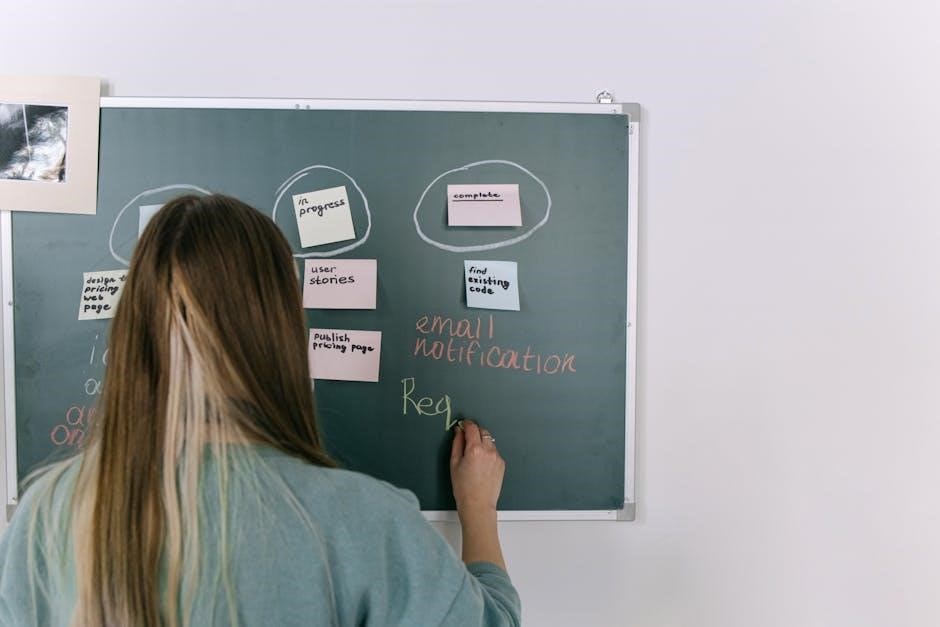Project Management: The Managerial Process‚ 8th Edition by Erik W. Larson and Clifford F. Gray is a comprehensive guide to modern project management. It combines practical tools with a focus on organizational culture‚ leadership‚ and cross-functional teams. This edition emphasizes realistic approaches‚ integrating technical and human elements for effective project outcomes. A leading resource for both students and professionals‚ it offers insights into managing complex projects in diverse environments.
Overview of the 8th Edition
The 8th edition of Project Management: The Managerial Process offers a comprehensive update‚ blending theoretical concepts with practical applications. It includes enhanced coverage of modern tools‚ techniques‚ and emerging trends in project management. The edition emphasizes the importance of organizational culture‚ leadership‚ and cross-functional teamwork‚ providing insights into managing global projects. With updated case studies and a focus on both technical and human dimensions‚ this edition is a valuable resource for professionals and students seeking to master project management skills in diverse environments. It also includes a solution manual and online resources for deeper learning.
Authors and Contributors: Erik W. Larson and Clifford F. Gray
Erik W. Larson and Clifford F. Gray are renowned experts in project management‚ bringing extensive academic and professional experience to the 8th edition. Larson is a distinguished professor with a focus on organizational behavior and project leadership‚ while Gray specializes in operations management and systems. Their collaboration ensures a balanced approach‚ blending theoretical knowledge with practical insights. Their work is widely recognized for its clarity and applicability‚ making the 8th edition a trusted resource for both educators and practitioners in the field of project management.
Key Features of the 8th Edition
The 8th edition of Project Management: The Managerial Process offers updated case studies‚ enhanced discussions on agile methodologies‚ and a stronger focus on cultural and organizational impacts. It includes practical tools like Gantt charts and risk assessment techniques‚ along with access to online resources and a solution manual. The text integrates real-world examples with theoretical concepts‚ providing a holistic view of project management. Its clear structure and engaging content make it an essential resource for both students and professionals seeking to master modern project management practices.

Core Concepts in Project Management
This section explores core concepts such as the project life cycle‚ stakeholders‚ and integration‚ providing a solid foundation for understanding project management principles and practices;

Definition and Scope of Project Management
Project management is the application of knowledge‚ skills‚ and techniques to execute projects effectively. It involves planning‚ organizing‚ and controlling resources to achieve specific goals within predefined constraints. The scope encompasses a broad range of activities‚ including defining objectives‚ managing stakeholders‚ and ensuring deliverables meet quality standards. This discipline integrates various aspects‚ such as time‚ cost‚ and risk management‚ to ensure successful project outcomes. By focusing on both technical and interpersonal skills‚ project management addresses the complexities of modern organizational environments‚ making it a critical component of business strategy and operational success.
The Project Life Cycle and Its Phases
The project life cycle is a structured framework that outlines the stages a project goes through‚ from initiation to completion. It typically consists of five phases: initiation‚ planning‚ execution‚ monitoring and controlling‚ and closing. Each phase serves a distinct purpose‚ ensuring a logical flow of activities. Initiation defines the project scope and objectives‚ while planning establishes detailed schedules and budgets. Execution involves carrying out the work‚ monitoring ensures progress alignment with plans‚ and closing formalizes the project’s completion. Understanding these phases is crucial for effective project management and delivering successful outcomes.
Project Stakeholders and Their Roles
Project stakeholders are individuals or groups with a vested interest in the project’s outcomes. They include sponsors‚ team members‚ customers‚ end-users‚ and organizations. Each stakeholder plays a unique role‚ such as providing resources‚ expertise‚ or decision-making support. Effective stakeholder management involves identifying their needs‚ expectations‚ and levels of influence to ensure alignment with project goals. The 8th edition emphasizes techniques like stakeholder analysis matrices to categorize and engage stakeholders appropriately‚ fostering collaboration and minimizing conflicts for successful project delivery.

Project Management Processes
Project management processes involve coordinating and overseeing activities to achieve project goals. Key processes include integration‚ scope‚ time‚ cost‚ quality‚ resource‚ communication‚ risk‚ and procurement management. These processes ensure projects are completed efficiently‚ aligning with organizational objectives while balancing technical and human aspects.
Integration Management: Coordinating Project Components
Integration management ensures seamless coordination of project components‚ processes‚ and stakeholders to achieve objectives. It involves developing a comprehensive project management plan‚ directing and managing work‚ and monitoring progress. This process integrates scope‚ schedule‚ budget‚ and quality‚ ensuring alignment with organizational goals. Key activities include coordinating changes‚ managing uncertainties‚ and ensuring deliverables meet expectations. Effective integration management fosters collaboration and minimizes risks‚ ultimately driving project success.
Scope Management: Defining and Managing Project Objectives
Scope management involves clearly defining and managing project objectives to ensure alignment with stakeholder expectations. It includes scope planning‚ definition‚ and control processes to prevent scope creep. Key activities include creating a detailed scope statement‚ work breakdown structure (WBS)‚ and managing changes. Effective scope management ensures deliverables meet specified requirements‚ enhancing project success and stakeholder satisfaction while minimizing deviations from the original plan.
Time Management: Scheduling and Controlling Project Timelines
Time management in project management involves creating and controlling schedules to ensure timely completion of deliverables. Key activities include defining activities‚ estimating durations‚ and sequencing tasks. Tools like Gantt charts‚ PERT‚ and CPM help visualize and manage timelines. Techniques such as critical path analysis identify essential tasks to prevent delays. Effective time management ensures projects meet deadlines‚ satisfy stakeholders‚ and maintain alignment with organizational goals. Continuous monitoring and adjustments are crucial to address deviations and keep the project on track. Proper scheduling enhances team productivity and resource utilization.
Cost Management: Budgeting and Cost Control Techniques
Cost management involves establishing and controlling budgets to ensure projects are completed within financial constraints. Key activities include cost estimation‚ budgeting‚ and cost control. Techniques like earned value management (EVM) and cost-benefit analysis help monitor expenditures and align spending with project goals. Regular financial reporting and variance analysis enable proactive adjustments to stay on budget. Effective cost management minimizes waste‚ optimizes resource allocation‚ and ensures deliverables meet stakeholder expectations while maintaining profitability. Proper budgeting and cost control are critical for project success and organizational sustainability.

Quality Management: Ensuring Project Deliverables Meet Standards
Quality management ensures that project deliverables meet predefined standards and stakeholder expectations. It involves planning‚ assurance‚ and control activities to maintain consistency and excellence. Tools like Pareto diagrams and checklists help identify and address quality issues. Continuous improvement practices‚ such as retrospectives and process audits‚ enhance overall project performance. By integrating quality management into each phase of the project life cycle‚ teams can deliver high-quality outcomes‚ foster customer satisfaction‚ and achieve long-term organizational success. Effective quality management is essential for building trust and ensuring project deliverables align with organizational goals.
Resource Management: Allocating and Managing Project Resources
Resource management involves efficiently allocating and managing project resources‚ including human capital‚ materials‚ and technology. It ensures that resources are available when needed and used effectively to meet project objectives. Tools like Gantt charts and resource leveling help optimize resource allocation. Effective resource management reduces conflicts‚ enhances productivity‚ and minimizes waste. It also involves monitoring resource utilization and making adjustments to ensure alignment with project goals. By prioritizing resource management‚ project managers can deliver successful outcomes while maintaining stakeholder satisfaction and organizational efficiency.
Communication Management: Effective Stakeholder Engagement

Communication management ensures effective stakeholder engagement through clear‚ timely‚ and tailored interactions. It involves planning‚ distributing‚ and monitoring information to meet project needs. Tools like communication matrices and feedback loops enhance clarity and reduce misunderstandings. Regular updates‚ active listening‚ and transparent reporting foster trust and alignment. Effective communication management addresses diverse stakeholder expectations‚ mitigates conflicts‚ and ensures shared understanding. By prioritizing stakeholder engagement‚ project managers can build collaboration and drive successful project outcomes while maintaining open and consistent dialogue throughout the project lifecycle.
Risk Management: Identifying and Mitigating Project Risks
Risk management involves systematically identifying‚ analyzing‚ and mitigating potential threats to project success. Tools like SWOT analysis and decision trees help prioritize risks based on likelihood and impact. Techniques such as contingency planning and sensitivity analysis prepare teams for uncertainties. Effective risk management enhances project resilience‚ minimizes disruptions‚ and ensures proactive responses to challenges. By addressing risks early‚ project managers can safeguard timelines‚ budgets‚ and quality‚ ultimately delivering successful outcomes.
Procurement Management: Contracting and Vendor Management
Procurement management involves acquiring goods and services from external sources‚ ensuring timely delivery and compliance with specifications. It includes vendor selection‚ contract negotiation‚ and relationship management; Tools like RFPs and RFQs facilitate supplier selection‚ while contract types such as fixed-price or cost-plus contracts align with project needs. Effective procurement management minimizes risks‚ ensures quality‚ and maintains cost efficiency. Clear communication and ethical practices are essential to build trust and foster long-term partnerships with vendors‚ ultimately supporting successful project execution and stakeholder satisfaction.

Tools and Techniques in Project Management
Project management tools and techniques include scheduling methods‚ cost estimation‚ quality control tools‚ and risk assessment. These tools enhance efficiency‚ decision-making‚ and project success.
Project Scheduling Tools: Gantt Charts‚ PERT‚ and CPM
Gantt Charts provide a visual timeline of project tasks‚ making it easy to track progress and dependencies. PERT (Program Evaluation and Review Technique) is ideal for complex projects‚ helping managers identify critical paths and potential bottlenecks. CPM (Critical Path Method) focuses on essential tasks to minimize delays. These tools enhance scheduling accuracy‚ resource allocation‚ and project control. By integrating these techniques‚ project managers can effectively plan‚ monitor‚ and adjust timelines to ensure successful outcomes.
Cost Estimating and Budgeting Techniques
Cost estimating involves predicting project expenses‚ ensuring realistic budgeting. Techniques like bottom-up estimating and three-point estimating enhance accuracy. Budgeting allocates resources to tasks‚ preventing overruns. Tools like earned value management and cost-benefit analysis optimize spending. Regular monitoring ensures alignment with financial goals‚ fostering transparency and stakeholder trust. Effective cost management is vital for project success‚ balancing quality and profitability while addressing potential financial risks proactively.
Quality Control Tools: Pareto Diagrams‚ Flowcharts‚ and Checklists
Pareto diagrams identify the most frequent issues‚ prioritizing problem-solving efforts. Flowcharts visualize processes‚ revealing inefficiencies and bottlenecks. Checklists ensure consistency‚ verifying adherence to standards. These tools collectively enhance quality control by systematically analyzing and improving processes. They help project teams detect defects early‚ streamline workflows‚ and maintain high deliverable standards. By leveraging these techniques‚ organizations can achieve greater precision‚ reduce errors‚ and ensure customer satisfaction in their projects.
Risk Assessment and Management Tools
Risk assessment and management tools are essential for identifying‚ analyzing‚ and mitigating potential project threats. Techniques like SWOT analysis and decision trees help evaluate risks. Probability-impact matrices prioritize risks based on likelihood and severity. Sensitivity analysis tests how project outcomes respond to variable changes. These tools enable proactive management‚ reducing uncertainties and enhancing project resilience. By systematically addressing risks‚ teams can develop contingency plans and ensure smoother project execution‚ ultimately improving overall outcomes and stakeholder confidence.

Cultural and Organizational Considerations
Cultural and organizational factors significantly influence project success. Organizational culture shapes team dynamics and decision-making processes‚ while leadership styles and cross-functional collaboration impact project outcomes. Understanding these elements ensures alignment with organizational goals and fosters a productive environment for both domestic and global teams.
The Impact of Organizational Culture on Project Management
Organizational culture profoundly influences project management outcomes. A culture that values collaboration‚ transparency‚ and innovation fosters trust and accountability among team members. Leadership styles‚ communication patterns‚ and decision-making processes are shaped by cultural norms‚ affecting how projects are planned and executed. A strong‚ adaptive culture enhances agility‚ while a rigid or misaligned culture can create resistance and hinder progress. Understanding and aligning cultural dynamics with project goals is essential for achieving success in both domestic and global project environments.
Leading and Managing Cross-Functional Teams
Leading cross-functional teams requires strong interpersonal and organizational skills. These teams‚ composed of members from diverse departments‚ demand effective communication and collaboration to align goals. Leaders must foster trust‚ resolve conflicts‚ and ensure clarity in roles and responsibilities. Active listening‚ empathy‚ and adaptability are critical in managing diverse perspectives. Utilizing collaboration tools and establishing clear communication channels enhances teamwork. Empowering team members and promoting a shared vision ensures accountability and drives successful project outcomes in dynamic environments. Effective leadership in cross-functional settings is key to leveraging collective expertise for achieving organizational objectives.
Global Project Management: Managing Cultural Diversity

Global project management involves navigating cultural differences to ensure successful outcomes. Cultural diversity can enhance creativity and innovation but also introduces challenges like communication barriers and conflicting work styles. Effective global project managers must understand cultural dimensions‚ such as time perception‚ decision-making practices‚ and hierarchy. Leveraging collaboration tools and fostering open communication helps bridge gaps. Building trust and respect across cultures is essential for aligning team goals. By embracing cultural diversity‚ managers can create inclusive environments that drive collaboration and achieve project success in multinational settings. Cultural competence is a cornerstone of effective global project leadership.

Additional Resources and Support
Additional resources include solution manuals‚ online case studies‚ and PDF downloads. These tools enhance understanding and application of project management concepts. Accessible via various platforms‚ they support both students and professionals in mastering the managerial process effectively.
Solution Manual for Project Management: The Managerial Process‚ 8th Edition
The Solution Manual for Project Management: The Managerial Process‚ 8th Edition provides detailed answers to chapter exercises‚ case studies‚ and problems. Designed to complement the textbook‚ it helps students and professionals master complex concepts. The manual covers all 16 chapters‚ offering clear explanations and practical examples. Verified and updated‚ it ensures accuracy and relevance. This resource is ideal for self-study‚ homework assistance‚ or exam preparation‚ enhancing understanding of project management principles and their real-world application. It is available in PDF format for easy access and reference.
Online Resources and Case Studies
Project Management: The Managerial Process‚ 8th Edition is supported by extensive online resources and case studies. These materials‚ including downloadable PDFs‚ provide practical examples and real-world scenarios to enhance learning. Accessible via platforms like McGraw-Hill and other academic sites‚ these resources offer in-depth analyses of project management challenges. Case studies cover diverse industries‚ allowing learners to apply theoretical concepts to actual situations. Additionally‚ online forums and communities share insights‚ making these resources invaluable for both students and professionals seeking to refine their project management skills and stay updated with industry trends.




Leave a Reply
You must be logged in to post a comment.